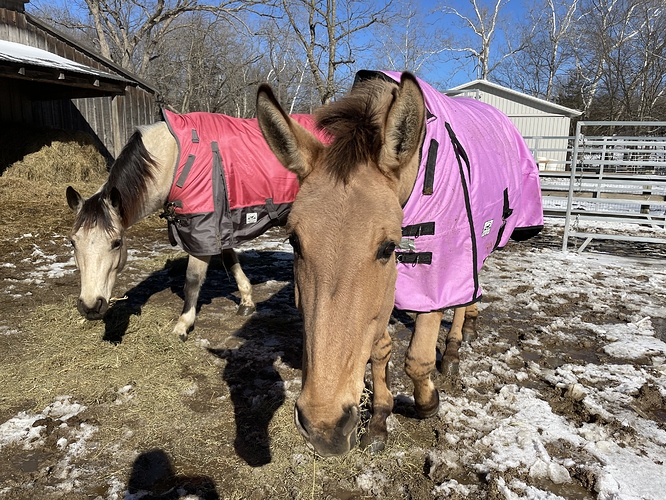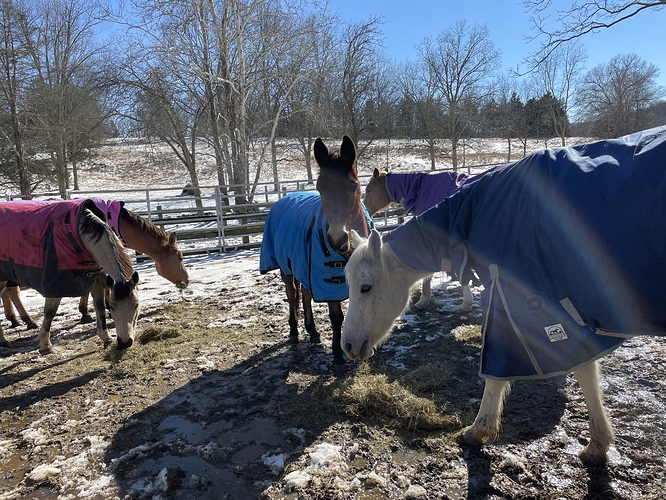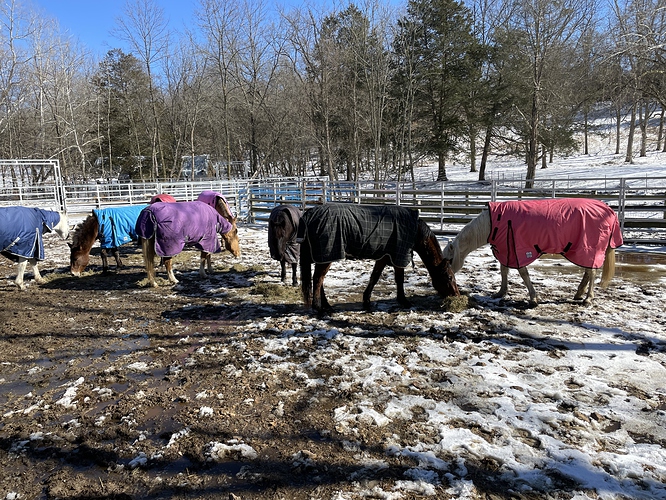How do you decide when to go the next layer warmer for a stable blanket? When it’s on the verge, my non scientific approach has been, if their nose or ears feel cold after being in the barn for a couple of hours, I layer up. Usually at that point under the blanket is ok, but not what i would call warm. I don’t want to over blanket, but want my horse to be comfortable. Any other methods?
I use turnout blankets, but I think knowing when to go up is hard!
Mostly I just fret and worry, then run down to the barn late at night to check horses.
Then I fret and worry some more.
I usually start with a temperature bases (eg: 0-10C use100g, -10-0C use 200g, below -10C use 300g) but of course all horses are different and clips can make a difference as well.
I like to check the back/kidney area to see how warm/cold they are. I also check around the shoulder chest area as well. If they feel cool to the touch in those spots, I layer up.
My ponies have a good winter coats right now (2 are trace clipped) and they wear a 100g stable blanket inside (heated barn around 5-8C) and I put a 100g turnout over top for temps to -10C or warmer with no hood and when its below -10C I use 300g turnouts with hoods for them. These are always overtop of their 100g stables. And I just remove turnouts when I bring them in.
In addition to this, though, check how they feel under their blanket before layering up. I often find that the ears may be cold, but they are very toasty warm under their blanket. I usually err on the side of a little less blanket and a little more hay when I’m on the fence, but I keep my horses at home and have the luxury to decide that.
Yes, if checking, check their “core” body area (chest, hq, etc). Ears, as extremities, are supposed to be cooler, so that’s not a good gauge.
Just blanketing in the first place is going up for my horses…well, half my horses anyway. (the mustangs grow their own coats). I called them in to de-frock today as it going up to 38, 26 tonight than 61 tomorrow… changed my mind and decided to leave their blankets on for all day today and tonight. I don’t see their hair popping back up as quickly as i was told it does. Maybe it depends on the horse? Anyhow, with blanket flat coat and 26 tonight i think i’ll leave them on. Here is my herd of easter eggs,( two blanketed individuals are missing as they wander the front yard
):an aside: i have three Rhino blankets and one Amigo and…i HATE them. Don’t fit right and are really hard to hook those belly straps. Their hooks do not work well at all.
That’s weird. My Amigos and Rhinos have the same blanket T and loop buckles that every other manufacturer uses.  Their rubber rings are a bit stiffer.
Their rubber rings are a bit stiffer.
As for the flat coat not fluffing as fast as you expect, the coat is flat because the horse is comfortably warm. They will fluff when they get cold enough to need the insulation. This can take time as horses have a large body mass and don’t lose heat as quickly as we puny humans do. It’s going to take longer in a sheltered, sunny area like you have in your pics.
Your buckskin mule in the pink blanket is super cute!
To answer the original question:
Temperature/horse/weather.
One of my horses gets cold easily and I generally have him one step heavier than my other horse. I know the temperature points for blankets on each horse and check the weather forecast to see how that will affect which blanket I choose. Cold horse gets blankets for the forecast low, and my other horse for the forecast high.
Don’t be afraid to get it wrong. You’ll learn something and be more confident in future.
They DO look like a herd of Easter eggs, how fun! 





